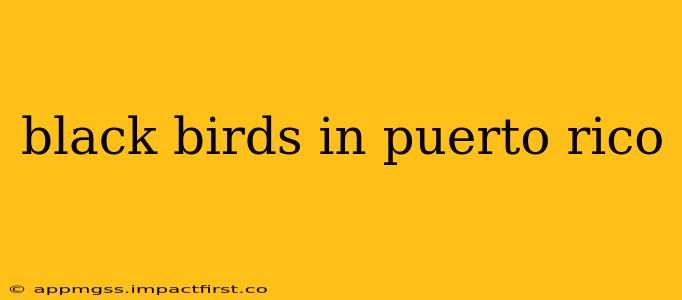Puerto Rico, a vibrant Caribbean island, boasts a diverse avian population. Among the most noticeable are several species of black birds, each with unique characteristics and habitats. This guide will explore the common black birds found in Puerto Rico, addressing frequently asked questions and providing valuable information for bird enthusiasts and casual observers alike.
What are some common black birds found in Puerto Rico?
Several species of black birds call Puerto Rico home. The most frequently sighted include the Great Tailed Grackle ( Quiscalus mexicanus), the Shiny Cowbird (Molothrus bonariensis), and various species of blackbirds within the Icteridae family. Identifying them accurately often requires close observation of size, plumage details (like iridescent sheen), and behavior. The Great Tailed Grackle, for example, is significantly larger than the Shiny Cowbird and displays a longer tail.
Are black birds in Puerto Rico harmful?
Generally, the black birds found in Puerto Rico are not inherently harmful to humans. However, like many bird species, they can be a nuisance in certain situations. Great Tailed Grackles, for instance, are known to be opportunistic feeders and may raid gardens or garbage cans. The Shiny Cowbird, a brood parasite, lays its eggs in the nests of other birds, potentially impacting the survival of the host species' young. Their impact is more on the ecosystem than on humans directly.
What do black birds in Puerto Rico eat?
The diet of black birds in Puerto Rico varies depending on the species. Great Tailed Grackles are omnivorous, consuming insects, fruits, seeds, and even small vertebrates. They are highly adaptable and will exploit various food sources. Shiny Cowbirds, being brood parasites, don't actively raise their own young and depend on the host birds to feed their offspring. Their dietary preferences are less relevant to understanding their impact on the ecosystem.
Where can I see black birds in Puerto Rico?
Black birds are relatively common across Puerto Rico. You're likely to spot them in various habitats, including urban areas, agricultural lands, forests, and wetlands. Parks, gardens, and even roadsides can provide good viewing opportunities. The Great Tailed Grackle, in particular, thrives in human-modified landscapes and is often seen near human settlements.
Are all black birds in Puerto Rico the same species?
No, not all black birds in Puerto Rico are the same species. As mentioned earlier, several species exhibit various sizes, plumage variations, and behavioral differences. Accurate identification requires careful observation and potentially the use of field guides or bird identification apps. Variations in plumage can also occur within a single species due to age and sex.
How can I attract black birds to my backyard in Puerto Rico?
Attracting black birds to your backyard involves providing suitable food and shelter. Offering a variety of seeds, fruits, and water sources can increase your chances of attracting them. Planting native plants that produce berries or seeds is a more natural and sustainable approach. Maintaining a source of fresh water, such as a bird bath, is also crucial, especially during dry periods. Remember that attracting a wider range of bird species will make your backyard a more dynamic and enjoyable ecosystem.
What is the conservation status of black birds in Puerto Rico?
The conservation status of black birds in Puerto Rico varies by species. While many are not currently considered threatened or endangered, habitat loss and degradation due to urbanization and agricultural expansion remain potential threats. Sustainable land management practices and protecting existing natural habitats are important for ensuring the continued presence of these birds on the island.
This comprehensive guide offers a deeper understanding of the black birds inhabiting Puerto Rico. Remember, responsible birdwatching practices, including maintaining a safe distance and minimizing disturbance to their natural habitats, are crucial for preserving these fascinating creatures for future generations.
